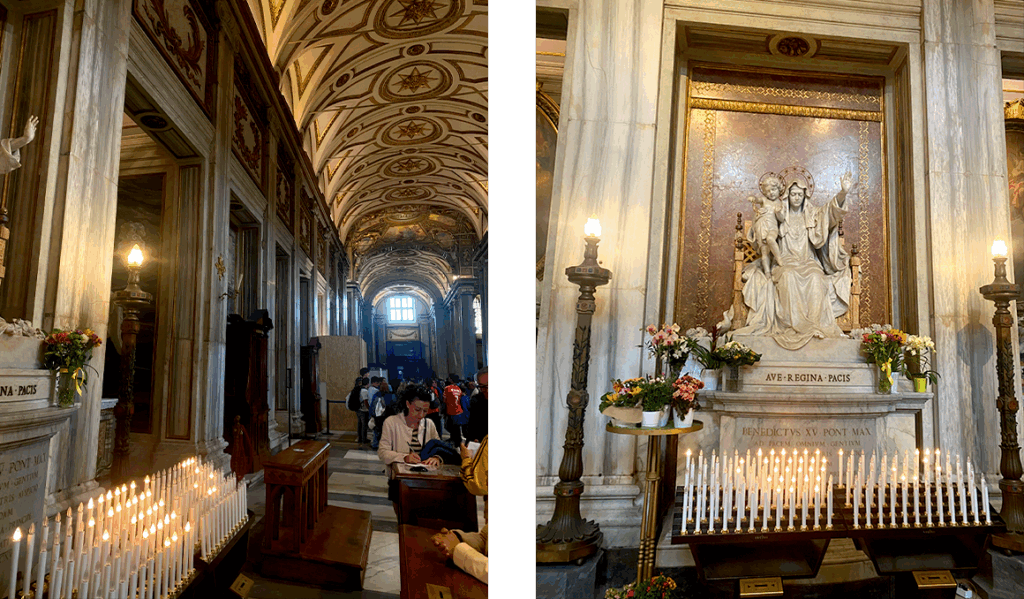
Essevu / Shutterstock
ROME // The cardinal stewarding Saint Mary Major Basilica, where Pope Francis will be buried, revealed this week that the pontiff initially intended to be buried in St. Peter’s Basilica, but changed his mind in 2022, saying Our Lady had inspired him.
The late Holy Father was known for his devotion to the Marian icon “Salus Populi Romani” (“Salvation of the Roman People”), which is housed in the St. Mary Major Basilica. He would pray before this Marian icon every time he was set to go on an international apostolic trip and every time he returned from one.
Cardinal Rolandas Makrickas, the co-Archpriest of St. Mary, said at a press conference outside the basilica April 25 that he had asked Pope Francis on May 13, 2022, if he was considering choosing St. Mary as the place for his tomb because of his strong devotion to the Marian icon. Only seven other popes are buried there.
“No” was Pope Francis’ response that day, and he said that he thought popes have to be buried at St. Peter’s Basilica, the cardinal recalled.
One week later, the pontiff called Cardinal Makrickas and said he had changed his mind.
The Pope said to the cardinal on the phone: “Mary told me, ‘Prepare your tomb,’” Cardinal Makrickas recalled. “And he added: ‘I am very glad that Mary didn’t forget me.’”
In deliberating where to be buried at St. Mary Major, Pope Francis did not want to choose the Pauline Chapel, the church’s side chapel, where the Marian icon is housed, “because chapels are for celebrations, for the Eucharist, and especially for the icon of Salus Populi Romani, and people should come here to pray and venerate Mary, and not look to the former pope,” Cardinal Makrickas said.
The pope decided his tomb would instead be between the Pauline Chapel and the Sforza Chapel, in a small space that has confessionals closeby on either side. According to Italy tour expert Tobias Jones, the alcove where Pope Francis chose for his tomb used to store candlesticks.
Vatican News reports that his tomb is inscribed “Franciscus” and is made of marble from Liguria, the region where his Italian grandparents were from.
As of April 25, the space in front of his tomb was covered with a temporary construction wall, cutting off visibility of the marble. A security guard and a restricted rope were in front of it. Just outside the rope was a long kneeler allowing mourners and pilgrims to stop a short distance away to pray for the repose of the Holy Father’s soul.
Past the confessional to the left of the tomb is a marble statue of Our Lady inscribed: Ave Regina Pacis, “Hail Queen of Peace.”

Just beyond the confessionals on the right side of the tomb is the entrance into the Pauline chapel, which houses the famous icon.
Cardinal Makrickas shared that Jesuit missionaries were also tasked with spreading devotion to the iconic image, which tradition holds was painted by St. Luke the Evangelist. Whenever Jesuits were set to leave for a mission, they received images of this painting to share.
The tomb is also on the same side of the church as one of Rome’s four holy doors, which pilgrims can pass through during Jubilee Year 2025 to gain a plenary indulgence following the usual conditions. On April 6, in one of his last public appearances before his death, Pope Francis visited St. Peter’s Square on the Jubilee of the Sick, just after passing through St. Peter’s Holy Door himself. Vatican News reports that he took the necessary steps, along with passing through the Holy Door, to gain the Jubilee indulgence.
The funeral Mass for Pope Francis is set for April 26 at 10 am local time.
>> CV Vice President pens ‘farewell, Francis’ <<
